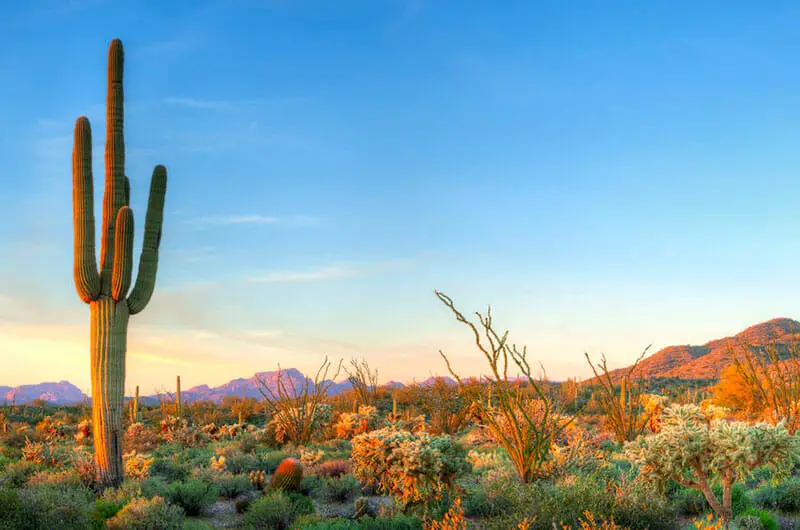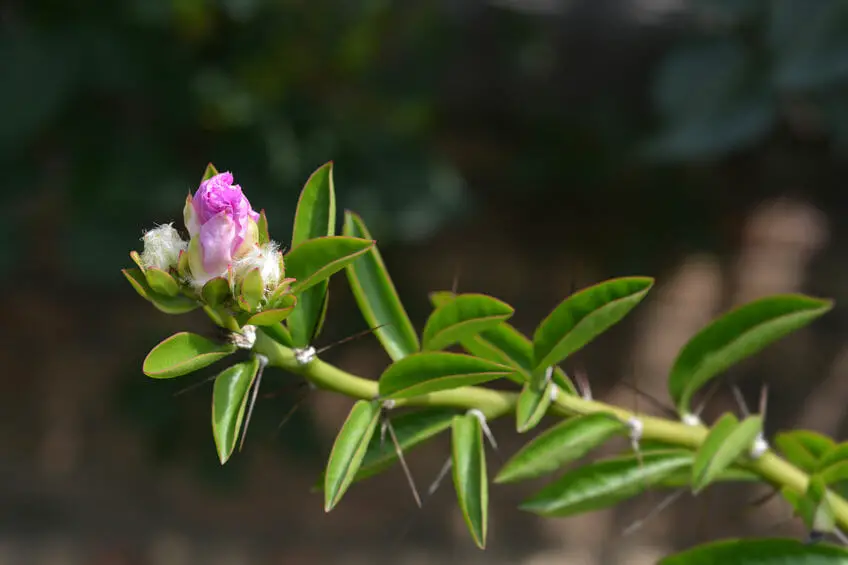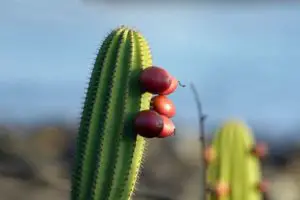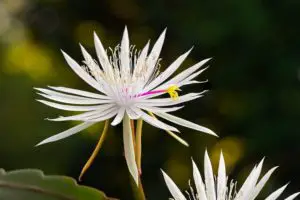Deserts are harsh. Between the searing heat and lack of water, it’s a wonder anything can survive at all.
And yet, cacti thrive even in the Atacama Desert, one of the driest places on the planet. How do Cacti survive in the Desert?
Cacti are able to survive in the desert because they’re designed to! There are a whole range of tricks that cacti use to beat the heat and soak up every stray drop of water.
Check out the traits that set these desert-dwellers apart.

Cacti Adapted To Use Spines Instead of Leaves
Though there are a few varieties of cacti that have leaves, these are in the distinct minority.
Most cacti are fleshy, leafless stems covered in prickly spines.
Though these spines might seem like nothing more than a good reason not to hug a cactus, they actually serve several purposes that help cacti survive in the desert.
To Save Water
One of the major ways a plant loses water is through its stomata, which, in most plants, are found on the leaves.
In environments where water is plentiful and light is scarce—like the rainforest floor, for example—you’ll find lots of plants with big, broad leaves.
Cacti, however, have the opposite problem, since they live where light is plentiful and water hard to come by.
Fewer stomata, found on the fleshy stem instead of on broad leaves, served cacti better, so they adapted to have smaller and more specialized leaves, which, over time, became the spines we’re familiar with today.
To Deter Thirsty Animals
Those prickly spines have an additional benefit—they deter would-be water thieves!
Because of their ability to store water even through the driest parts of the year, cacti can find themselves the target of desert-dwelling animals looking for moisture.
Spines help deter these thirsty critters from taking a bite out of the cactus’s hard-won water supply, though you may see older cacti with scars where desperate animals were willing to risk a spiny mouthful.
To Collect Water
In some species of cactus, spines also serve as a water collection system.
In the cool of the night, delicate spines give dew a place to condense.
As precious droplets build up, the angle of the spines encourages the drops to fall at the base of the cactus, or to roll down its stem to the ground, where it can be absorbed and stored for later.
They Work The Desert Night Shift

One of the unique hallmarks of plants is their ability to photosynthesize—they create the sugars they need to fuel their metabolism using water, carbon dioxide, and sunlight.
Cacti are no different, and, being desert dwellers, they have no problem getting enough sunlight and carbon dioxide.
Water, on the other hand, gets tricky.
Plants bring in the carbon dioxide they need through pores (called stomata) on their leaves.
Most plants open these stomata during the day to exchange the oxygen they produce for the carbon dioxide they need to keep making sugars, but for cacti, that’s risky.
Having open pores in the heat of the day is a great way to lose a lot of water to evaporation.
So instead, cacti work the night shift, releasing oxygen and collecting carbon dioxide while the sun is down to use during its next day of photosynthesis.
Its Roots Are Optimized To Collect Water In An Arid Climate
Most plants send out root systems designed to tap into the local groundwater supply, but what do you do when there’s no groundwater to be found?
In the rocky or sandy soil of a desert, cacti instead opt for a broad, shallow root system designed to make the most of every bit of rain that might fall.
During the driest seasons, the peripheral edges of a cactus’ root system will die back to help conserve water and keep the main plant alive.
As soon as the rains come, though, the cactus springs into action, sending out additional root tendrils to gather up as much water as it can before the rain begins to evaporate.
Cacti are so efficient at collecting water that some larger specimens have been known to soak up hundreds of gallons in a single rainstorm!
Cacti Conserve Energy To Survive And Take It Slow

Most of the time, cacti remain dormant. Metabolism, growth, and producing flowers and seeds are pretty energy intensive and require using up stored water.
Instead, cacti take it slow, reserving their growth and flowering for the rare wet seasons.
This is a common desert adaptation.
In fact, a desert after a rainstorm can be almost unrecognizable as all the plants suddenly burst into bloom and the dormant insects and animals emerge to gather up enough food and water for the next long drought.
They Are Able To Store Water For A Long Time
All plants are able to store water, but cacti have gotten very good at it.
They’re designed to store water from the cellular level right on up to the shape of the plants themselves.
Like all plants, the cells of a cactus have a stiff outer layer, called a cell wall, which prevents them from exploding when they’re filled with water.
The fleshy stems of cacti provide a lot of volume for water to be stored as it’s collected.
Their stems are also coated with a thick wax, which cacti use in much the same way we would—as waterproofing.
The only difference is in this case, the water is staying in instead of out!
Many cacti grow with ribs or ridges along their stems.
These act much like accordion folds, allowing the plant to expand as it fills with water.
Another common cactus shape—a globe—is another take on water storage.
A sphere provides maximum internal volume for water storage while minimizing the amount of surface area where that water could potentially evaporate.
Once a cactus has absorbed its fill of water, it can hold onto it for a very long time.
There have been documented cases of cacti going for years without any rainfall, and only to spring right back to life once the rains return.
They’re so good at retaining water that even dead cacti won’t part with it.
Because of their shallow root systems, tall cacti are prone to toppling in unusually strong winds.
Scientists once cut into a cactus that had been dead more than eight months, and its flesh was still filled with water!
There Are Exceptions To The Rules

Of course, there are black sheep in every family, and the cactus family is no different.
One group of cacti—the 17 species in the genus Pereskia—look almost nothing like your typical cactus.
They have stems and leaves, and actually look more like rose vines than anything else!
But it’s these exceptions that prove the rules.
These varieties of unusual cactus aren’t found in desert environments like most. Instead, you’ll find them in tropical environments in Brazil and other parts of South and Central America, where water is plentiful and the adaptations that keep most cacti alive aren’t necessary.
What This Means For Growing Cacti
Understanding how cacti survive in the desert is a great first step to keeping them alive in your own home or garden.
Their shallow root systems like to spread, so broad, shallow pots might be better than deep ones.
They’re accustomed to collecting dew rather than frequent rainstorms, so an occasional misting will probably be more effective than regular watering.
They grow in highly drained soil, so check regularly to see they never get soggy, and always make sure they’re situated in a warm place with plenty of heat and light.
Cacti are unique in the plant world.
Their strange and beautiful shapes and unusual growth habits make them the focus of study both by scientists and by gardeners!
They’re perfectly suited to the environments where they grow, and have adapted to even the harshest locations.
Do you have any question on this article, or fun cactus facts? Tips for growing your own cacti? Please Share them in the comments below 🙏🏻!


